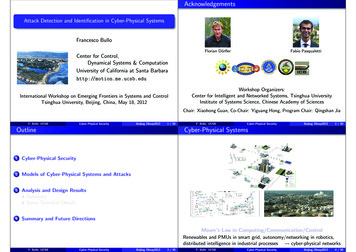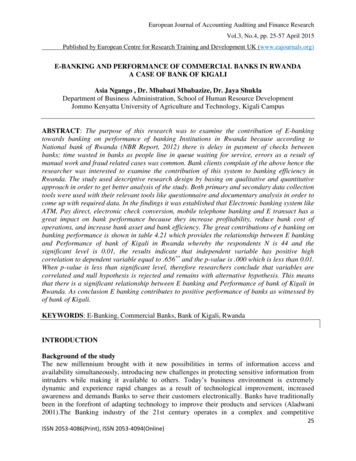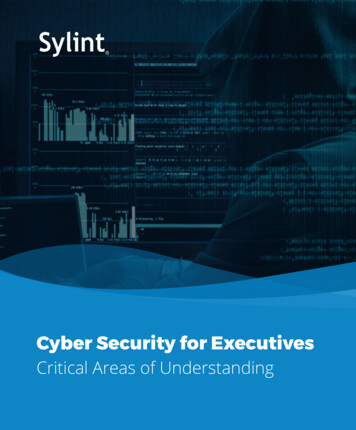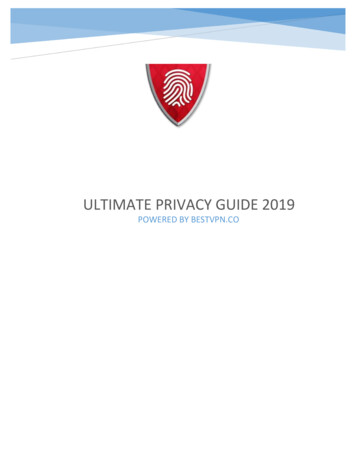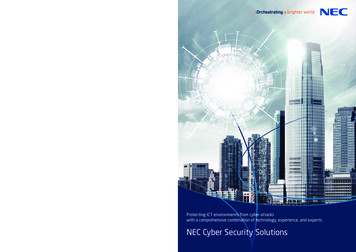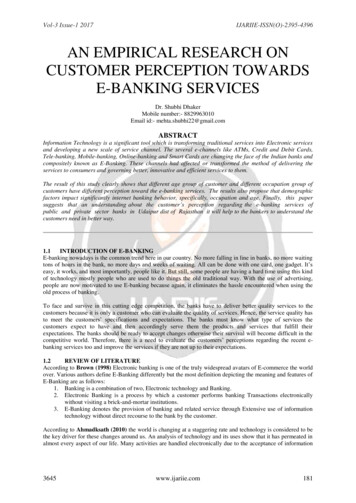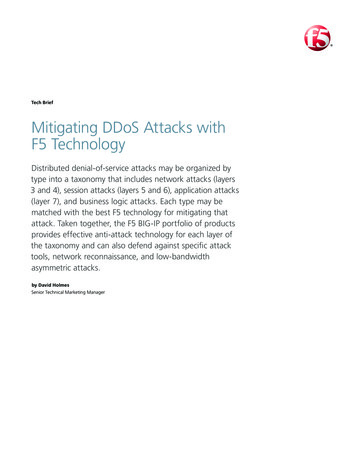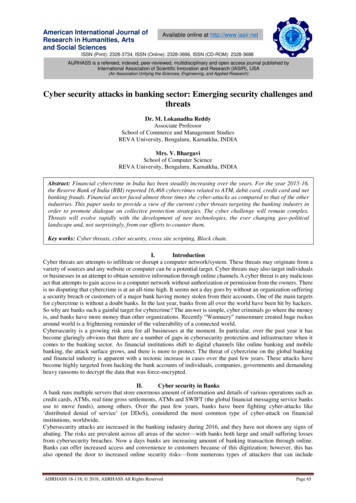
Transcription
American International Journal ofResearch in Humanities, Artsand Social SciencesAvailable online at http://www.iasir.netISSN (Print): 2328-3734, ISSN (Online): 2328-3696, ISSN (CD-ROM): 2328-3688AIJRHASS is a refereed, indexed, peer-reviewed, multidisciplinary and open access journal published byInternational Association of Scientific Innovation and Research (IASIR), USA(An Association Unifying the Sciences, Engineering, and Applied Research)Cyber security attacks in banking sector: Emerging security challenges andthreatsDr. M. Lokanadha ReddyAssociate ProfessorSchool of Commerce and Management StudiesREVA University, Bengaluru, Karnatkha, INDIAMrs. V. BhargaviSchool of Computer ScienceREVA University, Bengaluru, Karnatkha, INDIAAbstract: Financial cybercrime in India has been steadily increasing over the years. For the year 2015-16,the Reserve Bank of India (RBI) reported 16,468 cybercrimes related to ATM, debit card, credit card and netbanking frauds. Financial sector faced almost three times the cyber-attacks as compared to that of the otherindustries. This paper seeks to provide a view of the current cyber threats targeting the banking industry inorder to promote dialogue on collective protection strategies. The cyber challenge will remain complex.Threats will evolve rapidly with the development of new technologies, the ever changing geo-politicallandscape and, not surprisingly, from our efforts to counter them.Key works: Cyber threats, cyber security, cross site scripting, Block chain.I.IntroductionCyber threats are attempts to infiltrate or disrupt a computer network/system. These threats may originate from avariety of sources and any website or computer can be a potential target. Cyber threats may also target individualsor businesses in an attempt to obtain sensitive information through online channels.A cyber threat is any maliciousact that attempts to gain access to a computer network without authorization or permission from the owners. Thereis no disputing that cybercrime is at an all-time high. It seems not a day goes by without an organization sufferinga security breach or customers of a major bank having money stolen from their accounts. One of the main targetsfor cybercrime is without a doubt banks. In the last year, banks from all over the world have been hit by hackers.So why are banks such a gainful target for cybercrime? The answer is simple, cyber criminals go where the moneyis, and banks have more money than other organizations. Recently “Wannacry” ransonmare created huge ruckusaround world is a frightening reminder of the vulnerability of a connected world.Cybersecurity is a growing risk area for all businesses at the moment. In particular, over the past year it hasbecome glaringly obvious that there are a number of gaps in cybersecurity protection and infrastructure when itcomes to the banking sector. As financial institutions shift to digital channels like online banking and mobilebanking, the attack surface grows, and there is more to protect. The threat of cybercrime on the global bankingand financial industry is apparent with a tectonic increase in cases over the past few years. These attacks havebecome highly targeted from hacking the bank accounts of individuals, companies, governments and demandingheavy ransoms to decrypt the data that was force-encrypted.II.Cyber security in BanksA bank runs multiple servers that store enormous amount of information and details of various operations such ascredit cards, ATMs, real time gross settlements, ATMs and SWIFT (the global financial messaging service banksuse to move funds), among others. Over the past few years, banks have been fighting cyber-attacks like‘distributed denial of service’ (or DDoS), considered the most common type of cyber-attack on financialinstitutions, worldwide.Cybersecurity attacks are increased in the banking industry during 2016, and they have not shown any signs ofabating. The risks are prevalent across all areas of the sector—with banks both large and small suffering lossesfrom cybersecurity breaches. Now a days banks are increasing amount of banking transaction through online.Banks can offer increased access and convenience to customers because of this digitization; however, this hasalso opened the door to increased online security risks—from numerous types of attackers that can includeAIJRHASS 18-118; 2018, AIJRHASS All Rights ReservedPage 65
M. Lokanadha Reddy et al., American International Journal of Research in Humanities, Arts and Social Sciences, 21(1), December 2017February 2018, pp. 65-71insiders, various levels of thieves, people with political agendas and other third parties. Customers andstakeholders are left wondering, how will banks address the gaps in cybersecurity?Understandably, at numerous banks and financial institutions, chief risk officers have identified cyber-threats astheir top priority for 2017. This issue has been moved to the forefront of bank-board meeting agendas, and seniormanagers must act fast to diminish these growing threats to banks. Technological skill and access to resources forattackers have been growing at a faster pace than the defence-mechanism efforts have been enacted by banks.This needs to be tackled head-on in 2017 in order to get ahead of the problem.Cyber-attacks can take on many forms—most commonly the attackers are seeking to acquire capital as well asconfidential data and sensitive information. Based on the number of recent attacks, it is fair to estimate that manybanks are unprepared to deal with major cybersecurity attacks and need to address their financial-crime securityefforts across the board. 2017 will be a first and foremost year for assessing the extent of the gaps in cybersecurity.Before being able to devise a strategy or solution to close these gaps, banks need to tackle the challenge ofidentifying the gaps themselves—they must apply an intelligence-based approach in order to devise acomprehensive strategy. This in itself will be a significant task that will require the application of cybersecurityskilled specialists.III.Cyber Security Framework for BanksIn October 2016, the Reserve Bank of India directed banks to implement a security policy containing detailingtheir strategy to for dealing with cyber threats and including tangible “cyber-hygiene” measures. This wasfollowing a renewed emphasis on the early implementation of the RBI’s Cyber Security Framework in banks. TheRBI had first notified the ‘Cyber Security Framework’ in Banks in June 2016. The Framework was a successorto broad guidelines on information security and cyber frauds which had been issued in line with therecommendations of the Working Group on Information Security, Electronic Banking, Technology RiskManagement and Cyber Frauds in 2011.As per data reported by the Reserve Bank of India (RBI), the number of cybercrime pertaining to credit card,ATM, debit card and Internet banking shows a marginal increase of 4.4% from 13,083 in 2014-15, to 13,653 in2016-17.RBI has issued instructions to banks for reversal of erroneous debits arising from fraudulent or other transactions,and for Board-approved bank policy to cover customer protection, the mechanism of compensating the customerfor the unauthorised electronic banking transactions, and display of the same on the bank's website, along withthe details of grievance-handling / escalation procedure. Under the Banking Ombudsman Scheme, if a customerdoes not receive any reply within a period of one month after receipt of representation by the bank or is notsatisfied with the reply given, he can file a complaint before the Ombudsman, who can ask the bank to paycompensation of up to Rs. 20 lakh to the customer for loss, suffered by the customer due to an act of omission ofthe bank, and also compensation of up to Rs. 1 lakh for mental agony and harassment.The Framework is geared towards minimising data breaches and implementing immediate containment measuresin the event of such breaches. It emphasises the urgent need to put in place a robust cyber security and livelinessframework and to ensure continuous cybersecurity preparedness among banks. The Framework also mandates theadoption by banks of a distinct cybersecurity policy to combat threats in accordance with complexity of businessand acceptable levels of risk within a set deadline. Further, the framework requires the earliest setting upofSecurity Operations Centres within banks for continuous investigation, disallowing un-authorised access tonetworks and databases, protection of customer information and the evolution of a cyber crisis managementplan.Blockchain model is suggested to the financial institutions to secure their business transactions.AIJRHASS 18-118; 2018, AIJRHASS All Rights ReservedPage 66
M. Lokanadha Reddy et al., American International Journal of Research in Humanities, Arts and Social Sciences, 21(1), December 2017February 2018, pp. 65-71IV.Steps to be taken to secure from cyber threatsThereis urgent need to update the policy framework and make concerted and committedefforts to develop robustcyber security systems in our country. FortunatelyIndian government has set up a Cyber Swachta Kendra – Botnetcleaning andmalware analysis centre, which is providing tolls like USB Pratirodh, SamvidApp, M-Kavach etc., Centralgovernment must enhance cyber hygiene among all end-users and to create asecure and safeinternet ecosystems and The Centre Emergency Response Team(CERT-In) must co-ordinate requiredtasks. Banksmust practice a rigid cyber hygieneregimen to prevent malware infections on their systems and toensure securitythrough suitable anti-malware. Theother area that requires immediate attention is to increase insurance coveragefor cyber-attacks. Withrise in malware attacks, banks face increasing risks incyber space. Such attacks may lead to operationaland other securityinterruptions. Bankshas to aware their customers about cyber attacks and measures to be taken to staysecure and not tobreach any sensitive data. Banksmust also have an eye on insiders as there are instances where the employeesleaked highly secureddata for their malicious desires. Toproactively manage the vulnerabilities that could be exploited by hackers, updates have been rolledout by SWIFT, banks must follow them. Additionally, the Reserve Bank of India (RBI)as released a set of guidelines to manage the risksassociated with suchattacks. RBI’s circular last year covered several notable suggestions, rangingfromarrangements for continuous surveillance, creation of a cyber security policyetc., RBI also constitutedMeenaHemachandra committee to frame recommendationson Information Technology and CyberSecurity. Compared to today, the secure bank of the future will use more machine-learning technology and systemsto proactively prevent potential breaches and data loss. So, banks must ensure proactive prevention, and more unique layers of defence to protect the banks valueat most. So it is more than obvious now that the cyber vulnerabilities have massive global implications, so banksneeds to push for global rules on such issues otherwise our banks will be on tenterhooks wheneverransomware – like cyberattacks take place.V.Review of literatureClaessens et al., (2002)there are number of frauds or cybercrimes witnessed in the banking sector, like ATMfrauds, Cyber Money Laundering and redit Card Frauds. However, in general all the frauds are executed with theultimate goal of gaining access to user s bank account, steal funds and transfer it to some other bank account. Insome cases the cyber criminals uses the banking credentials like PIN, password, certificates, etc. to accessaccounts and steal meager amount of money; whereas in other cases they may want to steal all the money andAIJRHASS 18-118; 2018, AIJRHASS All Rights ReservedPage 67
M. Lokanadha Reddy et al., American International Journal of Research in Humanities, Arts and Social Sciences, 21(1), December 2017February 2018, pp. 65-71transfer the funds into mule accounts. Sometimes, the intention of cybercriminals is to just harm the image of thebank and therefore, they block the bank servers so that the clients are unable to access their accounts.Moore.T, Clayton.R&Anderson.R (2009) focused on the subject of online crime. Online crimes mostly occurfrom the nuisance came from amateur hackers. This paper looks at the data of online crime and many problems.Problems that banks and police forces face in controlling the traditional law enforcement. The analysis of thispaper show that significant improvements are possible in the way dealing with online fraud and to study the onlinecrime it is suggested that to understand its economic perspective.Florêncio&Herley, (2011) as a lot of vulnerabilities exist in the defense system of banking sector, thus there is aneed to investigate the ways to increase awareness about the measures that can be undertaken to combatcybercrimes in the banking sector. However, not many studies in the past have been conducted in this area whichwould suggest ways to mitigate the risks and combat such crimes.VI.Security ConsiderationsWhile each bank thinks distinctively on adopting various considerations it is imperative to assume that the themeremains the same for various banking channels:Internet Banking: Security controls like multi factor authentication, creation of strong passwords, adaptiveauthentication, image authentication, etc. can be considered.Mobile Banking: It should be ensured that mobile applications are up to date and should be tested. Latesthardening standards could be implemented.Wallet Transactions: Awareness material on Phishing, Malware attacks, vishing and social engineering,Password security etc. should be incorporated.ATM Security: Biometrics like eye-retina, voice scan or fingerprint scan should be introduced by Banks.Some of the Cyber Security Attacks on BanksBanks are exposed to a number of cyber security attacks. RBI in [1] identifies Phishing, Cross site scripting,Vishing, Cyber-Squatting, Bot networks, E-mail related crimes, Malware, SMS spoofing, Denial of serviceattacks, Pharming, Insider threats as the emerging information security attacks on banks.PhishingOne of the most common cyber frauds is ―Phishing‖. Phishing is an attack in which an attempt is made to obtainsensitive information of user such as usernames, passwords, credit card details, etc. by an attacker by pretendingto be a reliable body in an electronic communication. Phishing is typically carried out by email spoofing or instantmessaging in which users are asked to click on a link usually for securing their accounts. The users are thendirected to fraudulent websites which look alike the original banking website so that the user is deceived and isasked to enter his personal information such as usernames, passwords, credit card details, etc. Once the user entershis/her personal information, the fraudster then has access to the customer's online bank account and to the fundscontained in that account. There are a variety of tools and techniques used by phishers which serve a variety offunctions, including email delivery, phishing site hosting, and specialized malware. These tools include Botnets,Phishing Kits, Abuse of Domain Name Service (DNS), Technical Deceit, Session Hijacking and SpecializedMalware [19].A phishing incident was reported in Hyderabad [20], which was in the name of India’s central bank RBI in whichthe phishing email said that RBI had launched a new security system and asked users to click a link whichredirected users to a fake website. It asked users to enter their online bank credentials including card numbers andthe secret three digit CVV number, among others. RBI has cautioned people that it has not launched any suchsoftware as soon as it came to know about it.Cross site scriptingCross-site scripting (XSS) is a kind of cyber security vulnerability usually found in web applications and theyallow code injections by malicious web users into the web pages that are viewed by other users. Examples of suchcode include client-side scripts, HTML code, etc. A cross-site scripting vulnerability can be exploited by attackersto bypass access controls. Their impact ranges from a petty nuisance to a significant security risk, depending onthe sensitivity of the data that is handled by the vulnerable site and the nature of any security mitigationimplemented by the site's owner.VishingVishing is a cyber-attack in which social engineering and Voice over IP (VoIP) are used to access the private andfinancial information from the public for getting financial reward [1]. It combines "voice" and ―phishing‖.Vishing is an illegal practice where an attacker calls a user and pretends to be from a bank in which the user hasan account. He usually asks to verify the user’s account information (stating that user’s account has beensuspended, etc.) and once the user gives his credentials such as username, password, credit card number, etc., theattacker has easy access to the user’s account and the money in it. There has also been a theft of payment carddata of the customers of U.S. banks by various vishing attacks. In an attack in 2014, customers of a midsize bankreceived SMS text messages which claimed their debit card was deactivated and asked users to provide the cardand PIN numbers to reactivate it [21].AIJRHASS 18-118; 2018, AIJRHASS All Rights ReservedPage 68
M. Lokanadha Reddy et al., American International Journal of Research in Humanities, Arts and Social Sciences, 21(1), December 2017February 2018, pp. 65-71Cyber squattingCyber-squatting is a process in which a famous domain name is registered and then it is sold for a fortune. CyberSquatters register domain names which are similar to popular service providers’ domains so as to attract theirusers and benefit from it. Some countries have specific laws against cyber-squatting that are beyond the normalrules of trademark law. For example, the United States has the U.S. Anti-cybersquatting Consumer Protection Act(ACPA) of 1999 which provides protection against cybersquatting for individuals and also owners of distinctivetrademarked names. The Washington Post reported in 2007 that Dell filed a lawsuit against BelgiumDomains,CapitolDomains, and DomainDoorman for cyber-squatting and typo-squatting and dellfinacncialservices.comwas one of the domains that was cited [22].Bot NetworksBots are programs that infect a system to provide remote command and control access via a variety of protocols,such as HTTP, instant messaging, and peer-to-peer protocols. Several of bots under common control arecommonly referred to as a ―Botnet‖. Computers get associated with botnets when unaware users downloadmalware such as a ―Trojan Horse‖ which is sent as an e-mail attachment. The systems that are infected are termedas ―zombies‖. Illicit activities can be carried out with bots by the controller that include relays for sending spamand phishing emails, updates for existing malware, DDOS ,etc. Bot Networks create unique problems fororganizations because they can be upgraded very quickly remotely with new exploits, and this could help attackersprevent security efforts.MalwareMalware is a maliciously crafted software program that accesses and alters the computer system without theconsent of the user or owner. Malware includes viruses, Trojan horses, worms, etc. Malware can heavily influencethe confidentiality, integrity and availability of the banking system. Malwares have the capability to compromisethe information in the banking systems and may lead to a loss of worth millions to the bank. Malwares can targetboth the user’s system and the bank itself. E.g; Zeus.Denial of Service (DOS) AttackA DOS is an attack in which a user or an organisation is prevented from accessing a resource online. While as inDistributed denial-of-service Attack (DDOS), a specific system is targeted by a large group of compromisedsystems (usually called a Botnet) and make the services of the targeted system unavailable to its users.Actuallythe targeted system is flooded with incoming messages which causes it to shut down and thus the system isunavailable to its users.Although DOS attacks don’t usually result in loss of information or security to a bank, it can cost the bank a greatdeal of time, money and customers and can also destroy programming and files in affected computer systems.SMS TrickingIt is a relatively new technology in which a user receives a SMS message on phone which appears to be comingfrom a legitimate bank. In this SMS the originating mobile number (Sender ID) is replaced by alphanumeric text.Here a user may be fooled to give his/her online credentials and his/her money may be at risk of theft.TCP/IP SpoofingIt is one of the most common forms of online camouflage. In IP spoofing, illegal access is attempted on a systemby sending an email message to a victim that appears to come from a trusted machine by ―spoofing‖ the machines’IP address. IP address spoofing is a powerful technique as it can enable an attacker to send packets to a networkwithout being blocked by a firewall. This is because usually firewalls filter packets based on sender’s IP addressand they would normally filter out any external IP address. However using IP spoofing, the attacker’s data packetappears to come from legitimate IP address (internal network) and thus firewall is unable to intercept it. The maingoal here is to obtain root access to the victim’s server (here the banking system), allowing a backdoor entry pathinto the targeted systems [5].PharmingIt is also called farming or DNS poisoning. In this attack whenever a user tries to access a website, he/ she will beredirected to a fake site. Pharming can be done in two possible ways: one is by changing host’s files on a victim’scomputer and other way is by exploiting vulnerability in DNS server software. In January 2005, the domain namefor a large New York ISP, Panix, was hijacked and legitimate traffic was redirected to a fake website in Australia[23]. No financial losses are known. In January 2008, a drive-by pharming incident was reported by Symantecthat was directed against a Mexican bank and in which the DNS settings on a customer's home router were alteredafter receipt of an e-mail message that appeared to be from a legitimate Spanish-language greeting-card company[24].Insider ThreatsWith the increase in the use of information technology by banks, there is a high security risk to bank’s data byinsiders or employees of banks who can disclose, modify or access the information illegally. Also unintentionalerrors by employees can have devastating results. Healthy security processes must be used by banks to lessen suchthreats.OTP AttacksAIJRHASS 18-118; 2018, AIJRHASS All Rights ReservedPage 69
M. Lokanadha Reddy et al., American International Journal of Research in Humanities, Arts and Social Sciences, 21(1), December 2017February 2018, pp. 65-71OTP(one Time Password) is a two factor authentication method in which a password is created whenever theusers attempts authentication and the password is disposed of after use. A no. of attacks can be launched onaccounts that are OTP protected which are known as MIT-X methods (Man-In –The-X) [9].These are as follows:Man-in –the-middle attack (MITM): Here the transmission paths of data are accessed and information is snatchedin the middle of transactions.Man-in-the-Browser attack (MITB): Here malicious code exists in the web browser and it induces users to entercredentials and other important information into a fake form.Man-in-the-PC attack (MITPC): MITPC exploits the weaknesses in the hardware environment or operatingsystem to steal OTP.Security ChallengesThe rapid growth of digital payments platform in India and the impetus towards a cashless economy has renewedfocus on the need to strengthen cybersecurity posture. The following are the some of the Challenges.Strict compliance regulations: Managing regulatory compliances has become enormously challenging for thebanks. Over the past few years the volume of regulations has increased dramatically. Along with the larger banks,smaller ones too are required to fulfil the regulatory obligationsThe struggle to secure customer data: There are number of ways in which violation of privacy can take placein banking sector like stolen or loss card data, unauthorized sharing of data with third parties and loss of client’spersonal data due to improper security measuresThird party risk: Banks need to conduct due diligence on third parties they are associated with. As per Paymentscard industry data security standard, third parties need to report any critical issues associated the card dataenvironment to the bank.Evolving cyber threat landscape: The development in technologies is leading to the latest cyber threats like nextgeneration ransomwares, web attacks etc.Transaction frauds: Fraud detection technologies should be in place with proper consideration of risks based onthe business factors.Secure SDLC: Banks need to incorporate SDLC security for banking products and applications.VII.Recommendation to Prevent Cyber Crime1. Cyber Fraud Council in BanksWhenever a cyber-fraud is committed the victim should report to the Cyber Fraud Council that must be set up byin each and every bank to review, monitor investigate and report about cyber-crime. In case, such Council doesnot take perform or refuses to perform its duty then a provision to file an FIR must be made. The matter to bebrought before such council can be of any value. However, when the value is high then the Council shall actexpeditiously. RBI in its 2011 Report stated that when bank frauds are of less than one Crore then it may not benecessary to call for the attention of the Special Committee Board2. Education to CustomerThe customer should be educated and made aware about various bank frauds and measures should be informed tothem for safety mechanisms so that they do not fall prey as victims of cyber- crime. If a customer is consciousand report the matter of cyber-crime then in the initial stage also instances of cyber-crimes can be reduced. Acustomer should be made aware about the Dos and Don’ts’ of E-banking. It can be done through publishing it onthe bank’s website, publishing in the newspaper, through advertisements, by sending SMS alerts, through postereducation etc. In case a bank introduce any new policy or there are any changes which are required to be followedby all banks as per RBI then, bank must inform the customer through mails or by informing the customer throughtelephone. The awareness material should be timely updated keeping in mind the changes in the legislation andguidelines of RBI3. Training of Bank EmployeesTraining and Orientation programs must be conducted for the employees by the banks. The employees must bemade aware about fraud prevention measures. It can be done through newsletters or magazines throwing light onfrauds related aspects of banks by senior functionaries, putting up ‘Dos and Don’ts’ in the workplace of theemployees, safety tips being flashed on screen at the time of logging into Core Banking solution software, holdingdiscussions on factors causing cybercrime and actions required to be undertaken in handling them. Employeeswho go beyond their call of duty to prevent cyber frauds if rewarded will also enhance the work dedication4. Strong Encryption-Decryption MethodsE-banking activities must be dealt using Secure Sockets Layer (SSL). It provides encryption link of data betweena web server and an internet browser. The link makes sure that the data remains confidential and secure. As perIndia, we follow asymmetric crypto system which requires two keys, public and private, for encryption anddecryption of data.For SSL connection a SSL Certificate is required which is granted by the appropriate authorityunder IT Act, 2000. To ensure security transactions RBI suggested for Public Key Infrastructure in PaymentSystems such as RTGS, NEFT, Cheque Truncation System. According to RBI it would ensure a secure, safe andAIJRHASS 18-118; 2018, AIJRHASS All Rights ReservedPage 70
M. Lokanadha Reddy et al., American International Journal of Research in Humanities, Arts and Social Sciences, 21(1), December 2017February 2018, pp. 65-71sound system of payment. Wireless security solutions should also be incorporated. In cases of Denial of ServiceAttacks, banks should install and configure network security devices.5. Data protected technology adoptionBlock chain is a technology that was initially developed for Bitcoin, the cryptocurrency. Block chain could reducebanks infrastructure costs by US 15-20 billion per annum by 2022. Block chain have the potential to transformhow the business and the government work in vast variety of contexts.VIII. ConclusionInformation Technology has become the backbone of the banking system. It provides a tremendous support to theever increasing challenges and banking requirements. Presently, banks cannot think of introducing financialproduct without the presence of Information Technology. However Information Technology has an adverseimpact too on our banking sector where crimes like, phishing, hacking, forgery, cheating etc. are committed. Thereis a necessity to prevent cyber-crime by ensuring authentication, identification and verification techniques whena person enters into any kind of banking transaction in electronic medium. The growth in cyber-crime andcomplexity of its investigation procedure requires appropriate measures to be adopted. According to NationalCrime Records Bureau it was found that there has been a huge increase in the number of cyber-crimes in India inpast three years. Indian banking sector has carried out all their banking activities through electronic medium asthe study suggest that there has been an increase in the number of payments in online banking. However, thechange in the banking industr
ISSN (Print): 2328-3734, ISSN (Online): 2328-3696, ISSN (CD-ROM): 2328-3688 American International Journal of Research in Humanities, Arts and Social Sciences . As financial institutions shift to digital channels like online banking and mobile banking, the attack surface grows, and there is more to protect. The threat of cybercrime on the .


